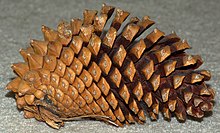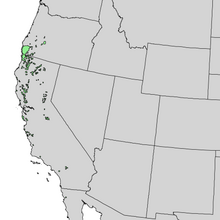Knobcone pine
| Knobcone pine | |
|---|---|

| |
| Knobcone pine cone | |
| Scientific classification | |
| Kingdom: | |
| Division: | |
| Class: | |
| Order: | |
| Family: | |
| Genus: | |
| Subgenus: | |
| Species: | P. attenuata
|
| Binomial name | |
| Pinus attenuata | |

| |
The knobcone pine, Pinus attenuata, (also called Pinus tuberculata[2]) is a tree that grows in mild climates on poor soils. It ranges from the mountains of southern Oregon to Baja California with the greatest concentration in northern California and the Oregon-California border.[3]
Description
The knobcone pine (Pinus attenuata) crown is usually conical with a straight trunk. It reaches heights of 8–24 metres (26–79 ft).[4] However, it can be a shrub on especially poor sites. It prefers dry rocky mountain soils. The bark is smooth, flaky and gray-brown when young, becoming dark gray-red-brown and shallowly furrowed into flat scaly ridges. The twigs are red-brown and often resinous.
The leaves are in fascicles of three,[5] needle-like, yellow-green, twisted, and 9–15 cm (about 3.5–6 in) long. The cones are 8–16 cm long and clustered in whorls of three to six on the branches. The scales end in a short stout prickle. The cones remain closed for many years until a fire opens them and allows reseeding. As a result, the cones may even become embedded in the trunk as the tree grows.
Ecology
The knobcone pine (Pinus attenuata) forms nearly pure stands, however it may hybridize with bishop pine (Pinus muricata), and Monterey pine (Pinus radiata) on the coast.
In the western foothills of the Sierra Nevada, knobcone pine is often a co-dominant with blue oak (Quercus douglasii).[6]
References
- ^ Farjon, A. (2013). "Pinus attenuata". The IUCN Red List of Threatened Species. 2013. IUCN: e.T42343A2974092. doi:10.2305/IUCN.UK.2013-1.RLTS.T42343A2974092.en. Retrieved 10 November 2017.
- ^ Chase, J. Smeaton (1911). Cone-bearing Trees of the California Mountains. Chicago: A. C. McClurg & Co. p. 99. LCCN 11004975. OCLC 3477527. LCC QK495.C75 C4, with illustrations by Carl Eytel - Kurut, Gary F. (2009), "Carl Eytel: Southern California Desert Artist", California State Library Foundation, Bulletin No. 95, pp. 17-20 retrieved Nov. 13, 2011
- ^ Moore, Gerry; Kershner, Bruce; Craig Tufts; Daniel Mathews; Gil Nelson; Spellenberg, Richard; Thieret, John W.; Terry Purinton; Block, Andrew (2008). National Wildlife Federation Field Guide to Trees of North America. New York: Sterling. p. 85. ISBN 1-4027-3875-7.
- ^ Gymnosperm Database, 2008
- ^ eNature Field Guides, 2007
- ^ C. Michael Hogan, 2008
Further reading
- Template:IUCN2006
- eNature Field Guides (2007) Knobcone Pine
- Gymnosperm Database (2008) Pinus attenuata
- C. Michael Hogan (2008) Blue Oak: Quercus douglasii, GlobalTwitcher.com, ed. Nicklas Stromberg
External links
- IUCN Red List least concern species
- Pinus
- Trees of the Southwestern United States
- Trees of Baja California
- Trees of the Northwestern United States
- Trees of the West Coast of the United States
- Flora of California
- Flora of the Cascade Range
- Flora of the Klamath Mountains
- Flora of the Sierra Nevada (U.S.)
- Natural history of the California Coast Ranges
- Natural history of the Peninsular Ranges
- Trees of Mediterranean climate
- Trees of mild maritime climate
- Least concern flora of California
- Least concern flora of the United States

